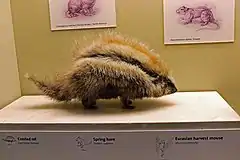| Lophiomyinae[1] | |||
| Milne-Edwards, 1867 | |||
 Przedstawiciel podrodziny – grzywak afrykański (Lophiomys imhausi) | |||
| Systematyka | |||
| Domena | |||
|---|---|---|---|
| Królestwo | |||
| Typ | |||
| Podtyp | |||
| Gromada | |||
| Podgromada | |||
| Rząd | |||
| Podrząd | |||
| Infrarząd | |||
| Nadrodzina | |||
| Rodzina | |||
| Podrodzina |
grzywaki | ||
| Typ nomenklatoryczny | |||
|
Lophiomys Milne-Edwards, 1867 | |||
| Synonimy | |||
|
| |||
| Rodzaje | |||
| |||
Grzywaki[7] (Lophiomyinae) – podrodzina ssaków z rodziny myszowatych (Muridae).
Zasięg występowania
Podrodzina obejmuje jeden żyjący współcześnie gatunek występujący we wschodniej Afryce[8][9]:
Podział systematyczny
Tradycyjnie Lophiomyinae umieszczany był w rodzinie Cricatidae[10], jednak badania przeprowadzone w 2015 wykazały, że L. imhausi jest taksonem bazalnym kladu obejmującego Deomyinae + Gerbillinae[11] które razem tworzą grupę siostrzaną z Murinae[12].
Do podrodziny należy jeden występujący współcześnie rodzaj[13][9][7]:
- Lophiomys Milne-Edwards, 1867 – grzywak – jedynym żyjącym przedstawicielem jest Lophiomys imhausi Milne-Edwards, 1867 – grzywak afrykański
Opisano również rodzaje wymarłe[14]:
Uwagi
- ↑ Pisownia oryginalna
Przypisy
- ↑ Lophiomyinae, [w:] Integrated Taxonomic Information System (ang.).
- ↑ A. Milne-Edwards. Mémoire sur le type d’une nouvelle famille de l’ordre des rongeurs. „Nouvelles archives du Muséum d’histoire naturelle”. 3, s. 114, 1867. (fr.).
- 1 2 T.N. Gill. Arrangement of the families of mammals. With analytical tables. Prepared for the Smithsonian institution. „Smithsonian Miscellaneous Collection”. 11, s. 20, 1872. (ang.).
- ↑ O. Thomas. On the Genera of Rodents: an Attempt to bring up to Date the current Arrangement of the Order. „Proceedings of the Zoological Society of London”. 1896, s. 1019, 1896. (ang.).
- ↑ G.S. Miller & J.W. Gidley. Synopsis of the supergeneric groups of rodents. „Journal of the Academy of Natural Sciences of Philadelphia”. 8, s. 437, 1918. (ang.).
- ↑ H.G. Stehlin & S. Schaub. Die Trigonodontie der Simplicidentaten Nager. „Schweizerische Palaeontologische Abhandlungen”. 67, s. 167, 1951. (niem.).
- 1 2 Nazwy polskie za: W. Cichocki, A. Ważna, J. Cichocki, E. Rajska-Jurgiel, A. Jasiński & W. Bogdanowicz: Polskie nazewnictwo ssaków świata. Warszawa: Muzeum i Instytut Zoologii PAN, 2015, s. 240. ISBN 978-83-88147-15-9. (pol. • ang.).
- ↑ Ch. Denys, P. Taylor & K. Aplin. Opisy gatunków Muridae: Ch. Denys, P. Taylor, C. Burgin, K. Aplin, P.-H. Fabre, R. Haslauer, J. Woinarski, B. Breed & J. Menzies: Family Muridae (True Mice and Rats, Gerbils and relatives). W: D.E. Wilson, R.A. Mittermeier & T.E. Lacher (redaktorzy): Handbook of the Mammals of the World. Cz. 7: Rodents II. Barcelona: Lynx Edicions, 2017, s. 650. ISBN 978-84-16728-04-6. (ang.).
- 1 2 C.J. Burgin, D.E. Wilson, R.A. Mittermeier, A.B. Rylands, T.E. Lacher & W. Sechrest: Illustrated Checklist of the Mammals of the World. Cz. 1: Monotremata to Rodentia. Barcelona: Lynx Edicions, 2020, s. 458. ISBN 978-84-16728-34-3. (ang.).
- ↑ D.E. Wilson & D.M. Reeder (redaktorzy): Subfamily Lophiomyinae. [w:] Mammal Species of the World. A Taxonomic and Geographic Reference (Wyd. 3) [on-line]. Johns Hopkins University Press, 2005. [dostęp 2021-01-19].
- ↑ Subfamily: Lophiomyinae. W: A. Monadjem, P.J. Taylor, Ch. Denys & F.P.D. Cotterill: Rodents of Sub-Saharan Africa: A biogeographic and taxonomic synthesis. Berlin: De Gruyter, 2015, s. 609–614. ISBN 978-3-11-030166-3. (ang.).
- ↑ J.J. Schenk, K.C Rowe & S.J. Steppan. Ecological opportunity and incumbency in the diversification of repeated continental colonizations by muroid rodents. „Systematic Biology”. 62 (6), s. 837-864, 2013. DOI: 10.1093/sysbio/syt050. (ang.).
- ↑ N. Upham, C. Burgin, J. Widness, M. Becker, C. Parker, S. Liphardt, I. Rochon & D. Huckaby: Treeview of Mammalian Taxonomy Hierarchy. [w:] ASM Mammal Diversity Database (Version 1.11) [on-line]. American Society of Mammalogists. [dostęp 2023-10-09]. (ang.).
- ↑ J.S. Zijlstra, Lophiomyinae Milne-Edwards, 1867, Hesperomys project (Version 23.8.1), DOI: 10.5281/zenodo.7654755 [dostęp 2023-10-09] (ang.).
- ↑ P. Mein & M. Pickford. Vallesian rodents from Sheikh Abdallah, Western Desert, Egypt. „Historical Biology”. 22 (1), s. 227, 2010. DOI: 10.1080/08912961003644104. (ang.).
- ↑ В.А. Топачевский & А.Ф. Скорик. Первая находка ископаемых остатков косматых хомяков — Lophiomyinae (Rodentia, Cricetidae) / The first find of a Lophomyinae (Rodentia, Cricetidae) fossil representative. „Вестник зоологии”. 1988 (2), s. 58, 1988. (ros. • ang.).
- ↑ J. Aguilar & L. Thaler. Protolophiomys ibericus nov. gen., nov. sp. (Mammalia, Rodentia) du Miocène supérieur de Salobreña (Sud de l’Espagne). „Comptes rendus hebdomadaires de l’Académie des Sciences”. Série II. 304 (14), s. 859, 1987. (fr.).
This article is issued from Wikipedia. The text is licensed under Creative Commons - Attribution - Sharealike. Additional terms may apply for the media files.